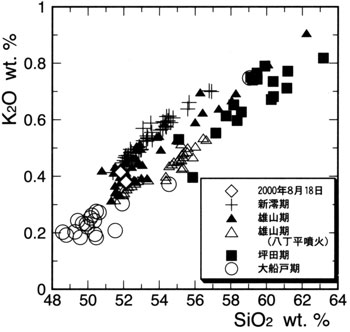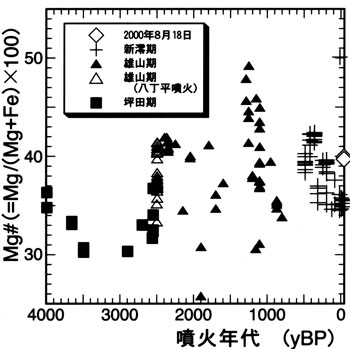Miyakejima Volcano
1: Introduction / 2: Topography of Miyakejima Volcano
3: History of eruptions of Miyakejima Volcano
4: Eruption of 2000 and collapse of the summit
5: Rocks of the Miyakejima Volcano
6: Possible future activities and hazard prediction / 7: Observation and monitoring
References
![]() PREV
PREV ![]() NEXT
NEXT
5: Rocks of the Miyakejima Volcano
The chemical compositions of Miyakejima volcanic ejecta show wide range from basaltic ( SiO2 48.5 wt % ) to andesitic ( 63 % ) within tholeiitic series. Lithological characteristics are closely related to activity stages ( ![]() Fig. 8 ). Those from Ofunato stage are basalts of 48.5 to 54.5 wt % in SiO2 with more than 20 volume % of plagioclase and olivine with or without augite phenocrysts. Those from Tsubota stage are andesites of 55 to 63 wt % SiO2 with phenocrysts of plagioclase and augite with or without olivine, and hypersthene and magnetite in addition. Volume of phenocrysts ranges from 7 to 27 %. Ejecta after Oyama stage are basalts to andesites mostly poor in phenocrysts ( less than 10 % ) with 51 to 57 % SiO2, and phenocrysts are plagioclase, olivine, and augite, with or without hypersthene and magnetite. Ejecta of Hatchodaira eruption at the first Oyama stage plot on a straight line on SiO2-oxide diagram suggesting that they represent mixing of andesite magma of Tsubota stage and new basaltic magma. Ejecta of Oyama stage after Hatchodaira eruption show repeated cycles of changes with time in bulk chemical compositions by suddenly turning to poorly differentiated state ( sudden increases of Mg#( =Mg/(Mg+Fe) x 100 ) ) followed by gradual decrease of Mg# (
Fig. 8 ). Those from Ofunato stage are basalts of 48.5 to 54.5 wt % in SiO2 with more than 20 volume % of plagioclase and olivine with or without augite phenocrysts. Those from Tsubota stage are andesites of 55 to 63 wt % SiO2 with phenocrysts of plagioclase and augite with or without olivine, and hypersthene and magnetite in addition. Volume of phenocrysts ranges from 7 to 27 %. Ejecta after Oyama stage are basalts to andesites mostly poor in phenocrysts ( less than 10 % ) with 51 to 57 % SiO2, and phenocrysts are plagioclase, olivine, and augite, with or without hypersthene and magnetite. Ejecta of Hatchodaira eruption at the first Oyama stage plot on a straight line on SiO2-oxide diagram suggesting that they represent mixing of andesite magma of Tsubota stage and new basaltic magma. Ejecta of Oyama stage after Hatchodaira eruption show repeated cycles of changes with time in bulk chemical compositions by suddenly turning to poorly differentiated state ( sudden increases of Mg#( =Mg/(Mg+Fe) x 100 ) ) followed by gradual decrease of Mg# ( ![]() Fig. 9 ). Beginning of each cycle corresponds to the beginning of Oyama stage and Shin-Mio stage at 2,500 and 500 yBP, respectively, and 1,300 yBP in the middle of Oyama stage.
Fig. 9 ). Beginning of each cycle corresponds to the beginning of Oyama stage and Shin-Mio stage at 2,500 and 500 yBP, respectively, and 1,300 yBP in the middle of Oyama stage.
Ejecta of 2000 consist of 2 kinds; One, similar to offshore Ako ejecta in 1983, which was well differentiated, and another, volcanic blocks of August 18th, which showed high Mg#. The latter may indicate that the eruption went into the new stage.


